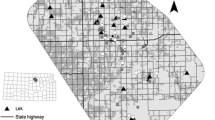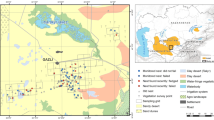Abstract
In the White River National Wildlife Refuge, we located and monitored 39 Mississippi Kite (Ictinia mississippiensis) nests during the 2004 and 2005 breeding seasons to examine reproductive success and causes of nesting failures. Nest failures were documented using five video recording systems. All kite nests not monitored with a video recording system were observed every 3 or 4 d. The apparent reproductive success during this study was 28.2% (n = 39 nests). Using the Mayfield estimator, we determined the nest success to be 36.3% over 1226 nest-exposure days with a daily nest survival of 0.9837. We recorded seven nest failures and eight probable predation attempts. Predation was the most common cause of nest failures of video observed nests (57%), with western rat snakes (Elaphe obsoletd) being the most common predator of kite eggs and nestlings. Other observed nest failures included nest abandonment, a chick falling out of a nest, and an infertile egg. Reproductive success reported in this study was the second lowest (28%) of all Mississippi Kite studies. This low reproductive success rate is likely not adequate to support a viable population in the White River National Wildlife Refuge, indicating this may currently be a sink population.
Similar content being viewed by others
Literature Cited
Anderson, D. J. and P. J. Hodum. 1993. Predator behavior favors clumped nesting in an oceanic seabird. Ecology 74: 2462–64.
Allan, P. F. 1947. Notes on Mississippi Kites in Hemphill County, Texas. Condor 49: 88–89.
Bader, T. J. 2007. Reproductive success, causes of nesting failures, and habitat use of Swallow-tailed and Mississippi kites in the White River National Wildlife Refuge, Arkansas. M.S. Thesis. Arkansas State University, Jonesboro, AR, USA.
Baerg, W. J. 1951. Birds of Arkansas. University Arkansas Agricultural Experiment Station, Bulletin No. 258 (rev.).
Barber, J. D., E. P. Wiggers, and R. B. Renken. 1998. Nest-site characterization and reproductive success of Mississippi Kites in the Mississippi River floodplains. Journal of Wildlife Management 62: 1373–78.
Bayne, E. M. and K. A. Hobson. 1997. Comparing the effects of landscape fragmentation by forestry and agriculture on predation of artificial nests. Conservation Biology 1: 1418–29.
Batary, P. and A. Baldi. 2004. Evidence of an edge effect on avian nest success. Conservation Biology 18: 389–400.
Bolen, E. G. and D. L. Flores. 1989. The Mississippi Kite in the environmental history of the Southern Great Plains. Prairie Naturalist 21: 65–74.
Bollinger, E. K. and R. G. Peak. 1995. Depredation of artificial avian nests: a comparison of forest-field and forest-lake edges. American Midland Naturalist 134: 200–03.
Bortolotti, G. R., K. L. Wiebe, and W. M. Iko. 1991. Cannibalism of nestling American kestrels by their parents and siblings. Canadian Journal of Zoology 69: 1447–53.
Chalfoun, A. D., M. J. Ratnaswamy, and F. R. Thompson, III. 2002. Songbird nest predation in forest-pasture edge and forest interior in a fragmented landscape. Ecological Applicatons 12: 858–67.
Chasko, G. G. and J. E. Gates. 1982. Avian habitat suitability along a transmission-line corridor in an oak-hickory forest region. Wildlife Monograms 46: 1–41.
Crocoll, S. T. 1994. Red-shouldered Hawk (Buteo lineatus). In The Birds of North America, No. 107, A. Poole and F. Gill (eds.) The Academy of Natural Sciences, Philadelphia, and the American Ornithologists’ Union, Washington, DC, USA.
Cutler, T. L. and D. E. Swann. 1999. Using remote photography in wildlife ecology: a review. Wildlife Society Bulletin 27: 571–81.
Evans, S. A. 1981. Ecology and behavior of the Mississippi Kite (Ictinia mississippiensis) in southern Illinois. M.S. Thesis, Southern Illinois University, Carbondale, IL, USA.
Fitch, H. S. 1963. Observations on the Mississippi Kite in southwestern Kansas. University of Kansas Museum of Natural History, Miscellaneous Publications 12: 503–19.
Gates, J. E. and N. R. Giffen. 1991. Neotropical migrant birds and edge effects at a forest-stream ecotones. Wilson Bulletin 103: 204–17.
Gennaro, A. L. 1988. Breeding biology of an urban population of Mississippi Kites in New Mexico. p. 188–90. In R. L. Glinski, et al. (eds.) Proceedings of the Southwest Raptor Management Symposium and Workshop. National Wildlife Federation, Washington, DC, USA.
Glinski, R. L. and R. D. Ohmart. 1983. Breeding ecology of the Mississippi Kite in Arizona. Condor 85: 200–07.
Goodrich, L. J., S. C. Crocoll, and S. E. Senner. 1996. Broadwinged Hawk (Buteo platypterus). In A. Poole and F. Gill (eds.) The Birds of North America, No. 218. The Academy of Natural Sciences, Philadelphia, and the American Ornithologists’ Union, Washington, DC, USA.
Gosselink, J. G. and L. C. Lee. 1989. Cumulative impact assessment in bottomland hardwood forests. Wetlands 9: 89–174.
Gosselink, J. G., G. P. Shaffer, L. C. Lee, D. M. Burdick, D. L. Childers, N. C. Leibowitz, S. C. Hamilton, R. Boumans, D. Cushman, S. Fields, M. Koch, and J. M. Visser. 1990. Landscape conservation in a forested wetland watershed. Can we manage cumulative impacts? Bioscience 40: 588–600.
Henny, C. J. and H. M. Wight. 1972. Population ecology and environmental pollution: red-tailed and Cooper’s hawks. Population ecology of migratory birds: a symposium. U.S. Department of Interior Research Report 2: 229–50.
Ingram, C. 1959. The importance of juvenile cannibalism in the breeding biology of certain birds of prey. Auk 76: 218–26.
Jackson, A. S. 1945. Mississippi Kite. Texas Game and Fish 3: 6–7, 26.
Lack, D. 1968. Ecological Adaptations for Breeding in Birds. Methuen, London, UK.
Macías-Duarte, A., A. B. Montoya, W. Grainger Hunt, A. Lafón-Terrazas, and R. Tafanelli. 2004. Reproduction, prey, and habitat of the Aplomado Falcon (Falco femoralis) in desert grasslands of Chihuahua, Mexico. Auk 121: 1081–93.
Marini, M. A., S. K. Robinson, and E. J. Heske. 1995. Edge effects on nest predation in the Shawnee National Forest, Southern Illinois. Biological Conservation 74: 203–13.
Martin, E. M. 2004. Decreases in a population of Red-shouldered Hawks nesting in central Maryland. Journal of Raptor Research 38: 312–19.
Martin, T. E., L. J. Ball, and J. Tweksbury. 1996. Environmental perturbations and rates of nest predation in birds. p. 43–49. In Transactions of the 61st North American Wildlife and Natural Resources Conference. Wildlife Management Institute, Washington, DC, USA.
Martin, T. E., J. Scott, and C. Menge. 2000. Nest predation increases with parental activity: separating nest site and parental activity effects. Proceedings Biological Sciences 267: 2287–93.
Mayfield, H. F. 1975. Suggestions for calculating nest success. Wilson Bulletin 87: 456–66.
Meanley, B. and J. A. Neff. 1953. Bird notes from the Grand Prairie of Arkansas. Wilson Bulletin 65: 200–01.
Miller, K. E. 2005. Red-tailed Hawk depredates Mississippi Kite nestling at dawn. Journal of Raptor Research 39: 108.
Miller, P. S. and R. C. Lacy. 2005. VORTEX. A stochastic simulation of the simulation process. Version 9.50 user’s manual. Conservation Breeding Specialist Group (IUCN/ SSC). Apple Valley, MN, USA.
Moore, D. M. 1991. Trees of Arkansas. Arkansas Forestry Commission, Little Rock, AR, USA.
Mullin, S. J. and R. J. Cooper. 1998. The foraging ecology of the gray rat snake (Elaphe obsolete)-Visual stimuli facilitate location of arboreal prey. American Midland Naturalist 140: 397–401.
Mullin, S. J. and R. J. Cooper. 2000. The foraging ecology of the gray rat snake (Elaphe obsolete). II. Influence of habitat structural complexity when searching for arboreal avian prey. Amphibia-Reptilia 21: 211–22.
Mullin, S. J., W. H. N. Gutzke, and G. D. Zenitsky. 2000. Home ranges of rat snakes (Colubridae: Elaphe) in different habitats. Herpetological Review 31: 20–22.
Newton, I. 1998. Population Limitation in Birds. Academic Press, New York, NY, USA.
Nour, N., E. Matthysen, and A. A. Dhonbt. 1993. Artificial nest predation and habitat fragmentation: different trends in birds and mammal predators. Ecography 16: 111–16.
Parker, J. W. 1974. The breeding biology of the Mississippi Kite in the Great Plains. Ph.D. diss., University of Kansas, Lawrence, KS, USA.
Parker, J. W. 1975. Populations of the Mississippi Kite in the Great Plains. p. 59–172. In J. R. Murphy, et al. (eds.) Population status of raptors. Proceedings of the Conference on Raptor Conservation Techniques, part 5.
Parker, J. W. 1988. Mississippi kite Ictinia mississippiensis. p. 166–86. In R. S. Palmer (ed.) Handbook of North American Birds. vol. 4 Yale University Press, New Haven, CT, USA.
Parker, J. W. 1999. Mississippi Kite (Ictinia mississippiensis). In A. Poole and F. Gill (eds.) The Birds of North America, No. 402. The Academy of Natural Sciences, Philadelphia, and the American Ornithologists’ Union, Washington, DC, USA.
Parker, J. W. and J. C. Ogden. 1979. The recent history and status of the Mississippi Kite. American Birds 33: 119–29.
Pilz, W. R. and L. K. Seibert. 1978. Fratricide and cannibalism in Swainson’s Hawk. Auk 95: 584–85.
Poole, A. 1982. Brood reduction in temperate and sub-tropical Ospreys. Oecologia 53: 111–19.
Porneluzi, P., J. C. Bednarz, L. J. Goodrich, N. Zawada, and J. Hoover. 1993. Reproductive performance of territorial Ovenbirds occupying forest fragments and a contiguous forest in Pennsylvania. Conservation Biology 7: 618–22.
Rich, T. D., C. J. Beardmore, H. Berlanga, P. J. Blancher, M. S. W. Bradstreet, G. S. Butcher, D. W. Demarest, E. H. Dunn, W. C. Hunter, E. E. Inigo-Elias, J. A. Kennedy, A. M. Martell, A. O. Panjabi, D. N. Pashley, K. V. Rosenberg, C. M. Rustay, J. S. Wendt, and T. C. Will. 2004. Partners in flight North American Landbird Conservation Plan. Cornell Lab of Ornithology, Ithaca, NY, USA.
Rosenfield, R. N. and J. Beilefeldt. 1993. Cooper’s Hawk (Accipiter cooperii). In The Birds of North America, No. 402, A. Poole and F. Gill (eds.) The Academy of Natural Sciences, Philadelphia, and the American Ornithologists’ Union, Washington, DC, USA.
Saracco, J. F. and J. A. Collazo. 1999. Predation on artificial nests along three edge types in a North Carolina bottomland hardwood forest. Wilson Bulletin 111: 541–49.
Shaw, D. M. 1985. The breeding biology of urban-nesting Mississippi Kite (Ictinia mississippiensis) in west central Texas. M.S. thesis, Angelo State University. San Angelo, TX, USA.
Small, M. F. and M. L. Hunter. 1988. Forest fragmentation and avian nest predation in forested landscapes. Oecologia 76: 62–64.
Steenhof, K. and I. Newton. 2007. Chapter 11-Assessing nesting success and productivity. p. 181–91. In D. M. Bird and K. L. Bildstein (eds.) Raptor Research and Management Techniques. Hancock House, Blaine, WA, USA.
St. Pierre, A. M. 2006. Reproductive ecology of Swallow-tailed and Mississippi kites in southeastern Arkansas. M.S. Thesis, Arkansas State University, Jonesboro, AR, USA.
Sutton, G. M. 1939. The Mississippi Kite in spring. Condor 41: 41–53.
Vander Haegen, W. M. and R. M. DeGraaf. 1996. Predation on artificial nests in forested riparian buffer strips. Journal of Wildlife Management 60: 542–50.
Whitmar, W. II. 1987. Quantification of the nesting site components in the Mississippi Kite (Ictinia mississippiensis). M.S. Thesis, Southern Missouri State University, Cape Girardeau, MO, USA.
Yahner, R. H. and D. P. Scott. 1988. Effects of forest fragmentation of depredation of artificial nests. Journal of Wildlife Management 52: 158–61.
Zhang, M., K. Wang, Y. Wang, C. Guo, B. Li, and H. Huang. 2007. Recovery of a rodent community in an agro-ecosystem after flooding. Journal of Zoology 272: 138–47.
Author information
Authors and Affiliations
Corresponding author
Rights and permissions
About this article
Cite this article
Bader, T.J., Bednarz, J.C. Reproductive success and causes of nest failures for Mississippi Kites: A sink population in eastern Arkansas?. Wetlands 29, 598–606 (2009). https://doi.org/10.1672/08-53.1
Received:
Accepted:
Issue Date:
DOI: https://doi.org/10.1672/08-53.1




